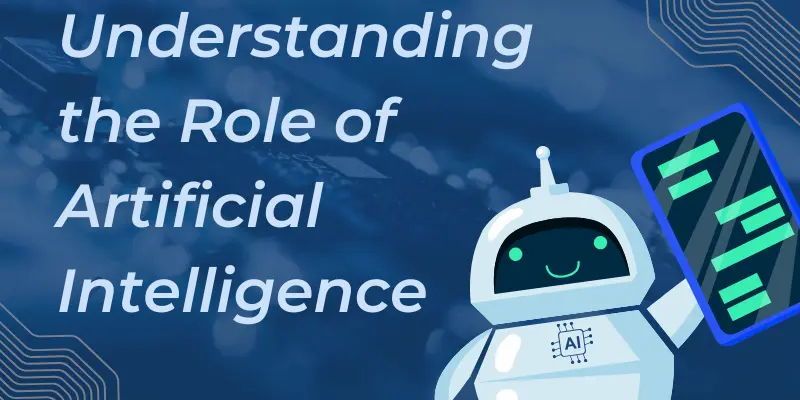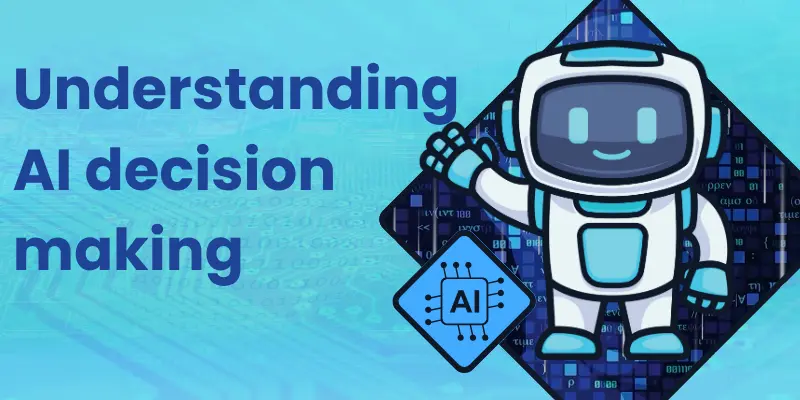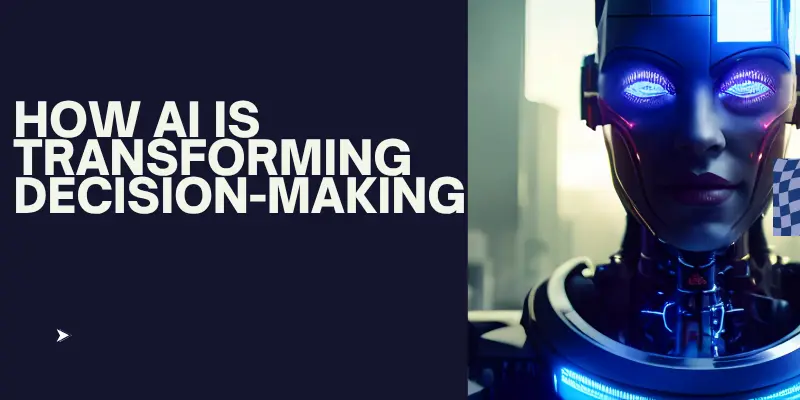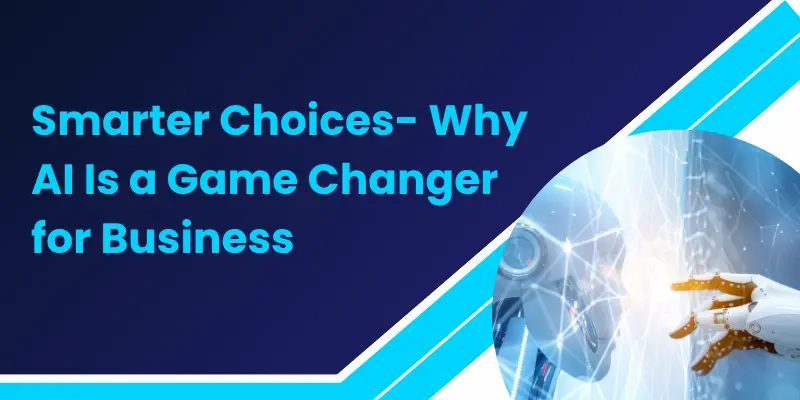AI in Business Decision- Making 7 Powerful Ways to Grow
Published: 17 Jun 2025
In today’s competitive world, AI in business decision-making is changing how companies operate. What once required hours of guesswork can now be done in minutes with greater accuracy and consistency. By combining machine learning, NLP, and computer vision, AI uncovers insights that help leaders make smarter choices. I’ve seen businesses boost profits and improve customer service simply by using AI to understand real needs. Human judgment isn’t replaced—it’s enhanced, making every decision more informed and future-ready.
Understanding the Role of Artificial Intelligence
When I first worked with machines that could learn from data and improve over time, I realized the true power of artificial intelligence. At its core, AI is about using technology to replicate human thinking -things like learning, problem-solving, and decision-making.

This means fewer errors, quicker solutions, and smarter results. What used to take hours for a team now takes seconds for intelligent bots. It’s not just about speed; it’s about accuracy and removing repetitive tasks. The world of AI is constantly evolving, and today, it is present in ways we interact with every day.
There are different levels of intelligence within AI, and each one plays a key part in modern business. Assisted intelligence is where basic tasks like assembly line actions are done by automated systems. Then there’s augmented intelligence, a more advanced setup where both humans and machines work together, learning from one another to improve decision accuracy using intelligent information. Lastly, automation intelligence takes things further, allowing autonomous robots or self-driving cars to handle entire processes alone. I’ve personally seen how this shift helps companies make better use of people’s time by focusing on creative and strategic work instead of repetitive chores.
Understanding AI decision-making
In today’s fast-moving business world, AI plays a key role in business decision-making. When it comes to data processing, an AI platform can take over many tasks that humans used to handle.

This means less chance for error and more ability to quantify data quickly. Using AI, companies get accurate predictions and can make precise decisions without delay.
From anomaly detection to data crunching and complex analysis, AI improves how decisions are made. It can spot trends and optimize the decision process faster than any human can. In many cases, this is part of automating business processes, where AI handles repetitive or data-heavy tasks to speed things up. Sometimes the final decisions are completely automated, but often humans still guide the human end of the process. In my experience, combining AI with human insight creates the strongest results for businesses aiming to stay ahead.
Levels of decision-making
When it comes to decision support, AI uses predictive, diagnostic, and descriptive analytics to help humans make better choices with more accuracy. The real advantage is how human intelligence mixes with data-driven insights. Combining common sense and expertise with AI gives the best results for businesses. From my experience, this partnership between AI and people improves how quickly and correctly decisions are made, making the whole process smoother and smarter.
Knowing When to Use AI in Decision-Making
In any organization, the time limit to make a choice and the complexity of the situation play a big role in deciding whether to use AI for decision automation, augmentation, or just support. The dimension of time can vary widely, from a few microseconds in high-frequency stock trading to several weeks for pay decisions, and even months or years for more strategic moves like acquisitions or mergers. The time between spotting an opportunity or threat and acting on it is crucial.
Using the Cynefin framework, complexity can be seen as a continuum. For simple situations like processing payrolls, where the rules are clear and follow a cause-and-effect relationship, decisions are usually predictable. More complicated circumstances, such as running marketing campaigns or managing assets, need deeper expertise, problem-solving, and detailed analysis to understand causes and effects. Then come complex situations, involving many interdependent relationships. These require a holistic or systemic approach, often using simulations to see how business intelligence impacts things like supply chain distributions. Finally, chaotic situations, like natural disasters or stock market crashes, have unclear causes and effects with dynamic interdependencies. In such cases, even the smallest change can have unreasonable effects, demanding practical learning and experimentation to make the most accurate decisions.
From my experience, understanding these layers helps you decide when AI can add value, whether automating quick, straightforward choices or supporting humans through complex, uncertain challenges.
How AI is Transforming Decision-Making
In today’s world, businesses rely more on artificial intelligence because of its impressive learning capability. AI uses data-driven decisions to improve continuously by training itself on vast data collections.

Using large language models (LLM), AI can analyze data in real-time, helping to make accurate decisions, categorization, and even recommendations. This leads to better commercial decisions and smarter business strategies overall.
Take companies like Amazon, for example; they use customer transaction data to understand which segment of customers buy certain products together. This AI model then recommends complementary products on their websites, improving customer recommendations and driving more purchases. Traditionally, humans were the central point of decision-making, manually analyzing data to decide who to target or what the cost of a product launch might be. This approach was often slow and risky, especially in marketing campaigns. But with AI, decisions are faster, smarter, and more reliable, changing the entire business landscape.
Decoding the Impact- Key Statistics on Harnessing AI for Decision Making
From my experience working closely with businesses adopting AI, the numbers reveal an interesting story. Since 2019, the adoption of artificial intelligence (AI) has shown remarkable growth, with many organizations embracing AI. The proportion of companies utilizing AI grew quickly but has recently plateaued between 50 percent and 60 percent. Looking back, in 2017, only about 20 percent of respondents were using AI in at least one business area, but by 2024, that number has risen sharply to 50 percent. AI is becoming a core part of many companies’ strategies.
The average number of AI tools each organization uses has also increased significantly. In 2018, companies used about 1.9 AI capabilities, which has now nearly doubled to 3.8 in 2023. Popular AI technologies like robotic process automation, computer vision, and natural-language text understanding are commonly deployed. These tools help analyze complex problems and streamline operations. When we look at the top use cases, optimization of service operations remains the most stable priority for decision-makers. AI is also heavily used in creating new products, customer service analytics, customer segmentation, and customer acquisition, all driving better operational efficiency and improving customer experiences.
Investment trends confirm AI’s growing role in business decision-making. A recent survey showed that over 40 percent of organizations once allocated more than 5 percent of their digital budgets to AI, but now more than half of the respondents report similar or higher levels of investment. Even more striking, 63 percent expect to increase their AI investments in the next three years, recognizing AI’s potential to deliver higher financial returns and a significant lead over competitors. AI’s value is evident across many areas, including manufacturing, marketing, risk management, product and service development, strategy, and corporate finance. Notably, supply chain management has emerged as a key area where AI delivers cost benefits. However, despite this progress, businesses must still carefully address ongoing risks, challenges and ensure ethical use of AI to make responsible decisions.
Smarter Choices- Why AI Is a Game Changer for Business
As someone who’s worked with tech-driven businesses, I’ve seen how artificial intelligence has quietly transformed the way we make everyday choices. It’s not just about automation anymore- it’s about building a strong foundation for smarter, faster actions.

The computer learning behind it lets systems harness massive amounts of data in seconds. And once the learned intelligence kicks in, it can deliver optimal decisions in just fractions of time-something no human can consistently match.
What makes this even more exciting is how AI supports key operations. It enhances the decision-making process by giving businesses the power to make immediate decisions after a quick analysis of large datasets. I’ve used AI tools like chatbots and machine learning algorithms to get a clearer view of target customers, and the results were eye-opening. These tools helped us measure customer satisfaction, predict expectations, and even personalize how we connect with users.
In another project, using the Natural Learning Process in our marketing campaigns allowed us to adjust the tone, words, and design to better match how customers interact with different brands. The sales lift we got felt like a direct result of this insight. More impressively, when working with complex data, AI showed it could uniquely position itself to make sense of it all-especially when the outcome was clearly defined and measurable. Whether it’s driving growth or simply keeping up with competition, AI is the silent partner every smart business needs.
Real-World Uses of AI in Smarter Business Decisions
In my work consulting for companies across different industries, I’ve often seen how AI transforms not just routine processes, but also how big choices are made. Before integrating artificial intelligence, executives struggled with data that was either too messy or too outdated to help. Today, AI-powered systems make decision-making faster and smarter. For instance, I helped a mid-sized retail brand integrate AI decision support systems into its operations. The result? Real-time forecasting of demand and sharper customer behavior insights, improving product distribution, and boosting automation efficiency.
We used modeling and simulations built on big data, and it quickly became clear how powerful augmented intelligence can be. With minimal intervention from humans, the system managed tasks like lead ranking, data recording, and contact management. These applications not only reduced labor but also allowed the team to focus on high-level decisions. One memorable moment was watching their CRM application identify a high customer lifetime value segment-something we would have never spotted manually. The insight helped restructure their campaign management and enabled more personalized offers, using opinion mining across social media networks and website analysis.
What impressed me most was the system’s ability to simulate buyer persona models and adapt to fast-changing market trends. It analyzed both physical and cognitive patterns in consumer behavior, and even adjusted to real-time search engines’ data. As a result, decision makers could now manage supply based on actual demand, not assumptions. This wasn’t just a revolutionary leap in how marketing decisions were made- it was a complete mindset shift, driven by AI acting as a capital hybrid between humans and machines. It’s no surprise that reports like those from the McKinsey Global Institute estimate 13 trillion dollars in extra output by 2030, with global GDP seeing a 12 percent annual bump. In the end, smarter automation, better data analysis, and refined campaigns all came from the smart use of AI-not guesswork.
The Future Role of AI in Business
Over the last few years, AI has grown thanks to faster computer processing, stronger IoT connectivity, and the rise of many connected devices. This has boosted data collection and analysis, allowing companies to explore AI in new ways, while some are already experienced veteran travelers in this field. Although there is still a long journey ahead, modern AI with narrow AI and data-trained models using machine learning and deep learning is already shaping the future of business.
In industries like transportation, we see self-driving cars leading transport optimization, ready to take over in the next decade. Meanwhile, AI-fueled robots are working with the human workforce in manufacturing, performing specific tasks such as stacking and assembling, while predictive analysis sensors help prevent failures and increase efficiency. The healthcare field is also evolving rapidly, with AI speeding up disease diagnosis, drug discovery, and offering virtual nursing assistants for constant patient monitoring. In education, AI research and digitized textbooks are changing how students learn, with facial analysis helping tailor experiences to individual needs.
From my experience, the real power of AI comes from its ability to combine big data, automation, and augmented intelligence to improve decision-making across industries. Whether it’s through natural learning processes used in media for quick insights or NLP decision making helping chatbots understand context better, AI is making business decisions smarter, faster, and more personalized than ever before.
Can AI Truly Replace Executive Decision-Making?
When it comes to human decision-making, the human force faces real limits. It is often humanly impossible for human minds to fully process the vast amount of collected data businesses generate today. Modern companies drown in overflowing data, making it hard for the human force to leverage all the insights hidden in millions or even billions of records. Humans tend to prioritize some information over others and are influenced by biases and emotion, which can lead to errors in judgment. Their approach is often linear, unable to connect complex relationships or patterns in large datasets.
On the other hand, AI or artificial intelligence can handle these huge volumes of data efficiently. It can summarize and process information without letting emotion cloud its decision-making. According to the Harvard Business Review, this raises the big question: Can AI make better decisions than humans? While AI lacks the moral and creative touch behind a marketing strategy or a customer support plan, it excels at objective, data-driven decision-making. The smartest business move might be a decision-making model that combines human intelligence and machine power. Such a blend can make innovative, dedicated, and smart choices, cutting through the noise of today’s complex business environment.
In my experience working with decision teams, the blend of human insight and AI’s data mastery leads to the most reliable results. While machines can cut through endless databases and spreadsheets quickly, it’s human intuition that ultimately takes charge of final decisions where values and ethics are involved.
Conclusion
AI in business decision-making is no longer a future concept—it’s today’s competitive advantage. By turning massive datasets into actionable insights with machine learning, NLP, and computer vision, AI empowers companies to act faster, smarter, and with greater confidence. From marketing and sales to product development and strategic planning, businesses that embrace AI see stronger efficiency and higher returns. While challenges like bias and implementation hurdles remain, the real winners will be those who adopt AI responsibly and use it to enhance—not replace—human judgment. If you’re exploring AI in business decision-making, now is the time to take action and future-proof your organization.
FAQs
There are several types of AI, including machine learning, natural language processing (NLP), and computer vision. Each type helps businesses analyze data and make decisions in different ways. For example, machine learning helps spot patterns, while NLP helps understand human language.
Machine learning is a type of AI where systems learn from data and improve over time without being explicitly programmed. It focuses mainly on predicting outcomes based on past data. Other AI types, like NLP, specialize in understanding text or speech instead.
Not all AI systems are fully autonomous. Some AI only assist humans by providing insights, while others can make simple decisions without human help. More complex decisions usually require a combination of AI and human judgment.
NLP allows computers to understand and interpret human language, which is helpful for analyzing customer feedback, emails, or social media posts. This helps businesses get clear insights without manually reading tons of text. It improves communication between humans and machines.
Computer vision lets AI “see” and analyze images or videos. In business, it can be used for quality control in manufacturing or analyzing customer behavior in stores. This visual data helps businesses make better and faster decisions.
Some AI types, like simple machine learning tools or chatbots using NLP, are becoming more accessible for small businesses. However, fully integrated systems can be complex and may require expert help. Starting small with AI tools is a good way to learn before scaling up.
Beginners often struggle with understanding how to collect and prepare the right datasets for AI. There can also be confusion about interpreting AI results or trusting AI decisions. It’s important to learn the basics and gradually build expertise.
AI is very powerful, but usually works best when combined with human intelligence. Humans provide context, ethics, and creativity that AI lacks. So, AI supports decision-making rather than replacing humans completely.
AI speeds up data analysis and automates repetitive tasks, freeing up humans to focus on strategy and creativity. This makes processes faster and less prone to errors. Over time, it helps businesses save time and money.
AI can sometimes make mistakes if the data is biased or incomplete. Over-relying on AI without human checks can lead to poor decisions. Businesses should always monitor AI performance and update systems regularly to reduce risks.3

- Be Respectful
- Stay Relevant
- Stay Positive
- True Feedback
- Encourage Discussion
- Avoid Spamming
- No Fake News
- Don't Copy-Paste
- No Personal Attacks

- Be Respectful
- Stay Relevant
- Stay Positive
- True Feedback
- Encourage Discussion
- Avoid Spamming
- No Fake News
- Don't Copy-Paste
- No Personal Attacks





